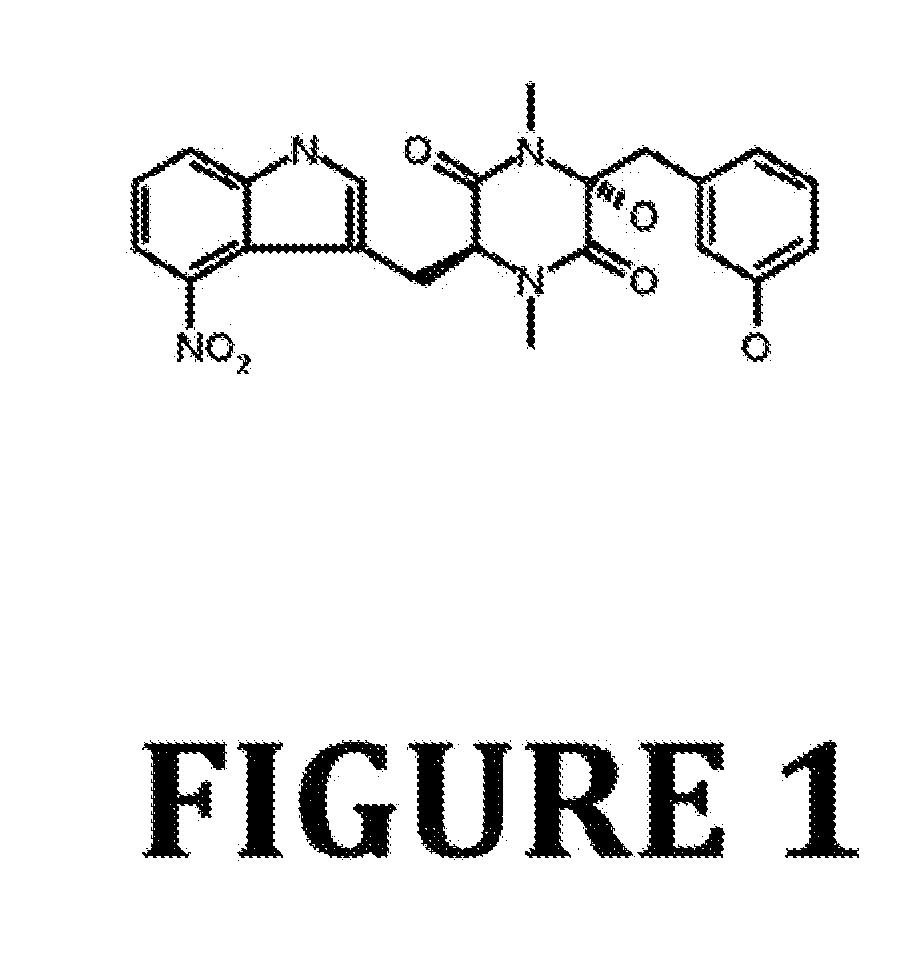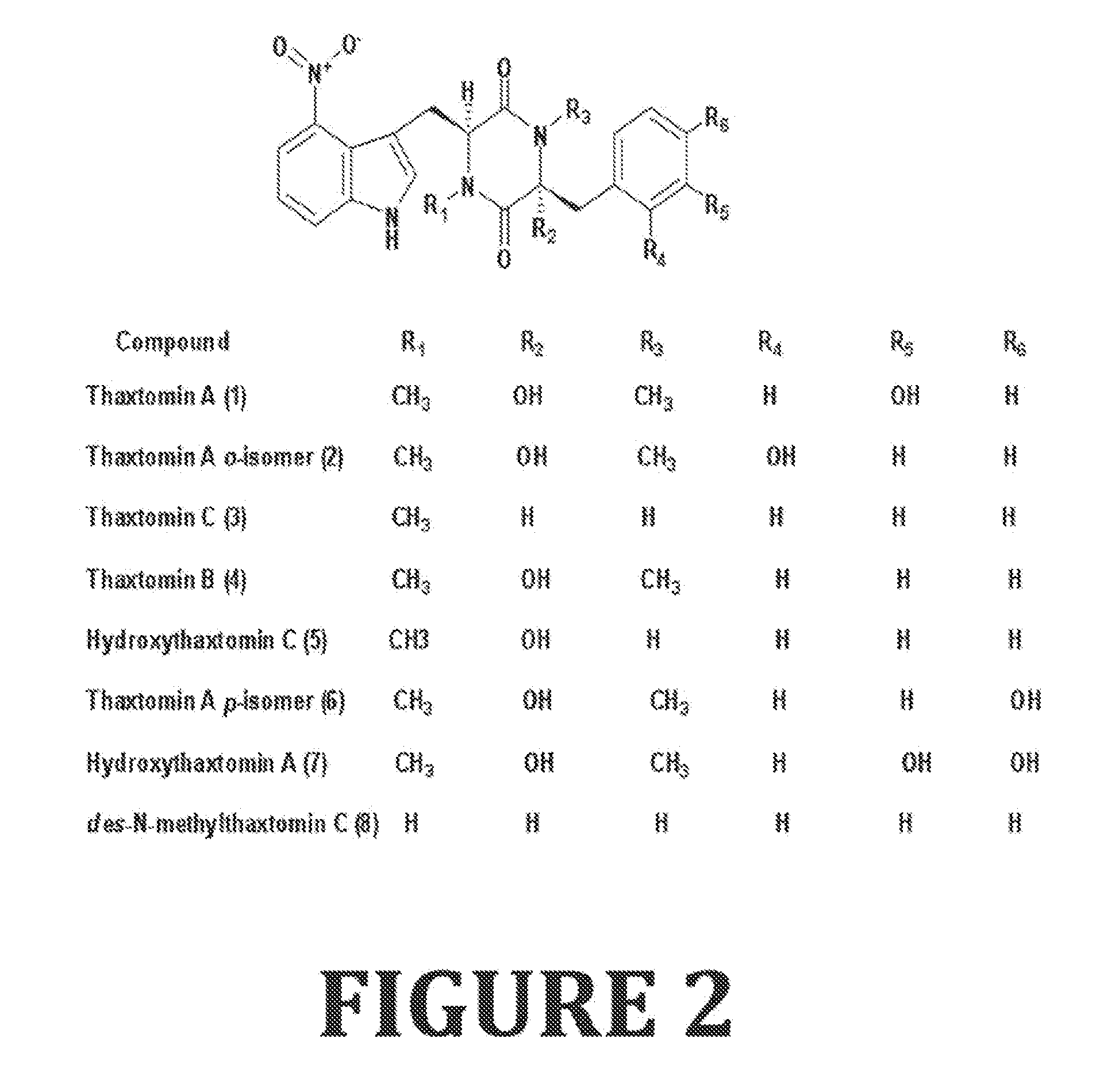Use of Thaxtomin for Selective Control of Rice and Aquatic Based Weeds
a technology of thaxtomin and selective control, which is applied in the direction of biocides, biocides, biocides, etc., can solve the problems of no selective herbicides available to control weeds in organic rice, and the yield loss of organic rice due to weeds can exceed 50%, so as to achieve the effect of not harming the environmen
- Summary
- Abstract
- Description
- Claims
- Application Information
AI Technical Summary
Benefits of technology
Problems solved by technology
Method used
Image
Examples
example 1
[0024]In the first study, thaxtomin A derived from a marine actinomycete BL37-EQ2-010 was tested from 64 to 1000 g a.i. per hectare and showed excellent (95-0.100%) control of Ammania species, Ducksalad and Cyperus difformis. Thaxtomin also exhibited complete safety to transplanted rice at all rates tested, while only slight growth reductions to direct-seeded rice were observed at rates up to 750 g a.i. per hectare. At higher rates (500-1000 g a.i. per hectare), thaxtomin A also displayed 90-100% control of Echinochloa colonum with moderate activity on barnyardgrass.
example 2
[0025]In a second pot study test in greenhouse conditions, treatments of thaxtomin A at 500 g a.i. per hectare showed 100% control of Monorhoria vaginalis, spp., Heteranthem limosa, Cyperus difformis. Sphenoclea zeylanica, Alisma-plamago aquatica and Cyperus iria with excellent rice selectivity on transplanted ‘M202 ’ Japonica-type rice, along with minimal growth inhibition (15%) to direct-seeded rice.
[0026]At 500 g a.i. per hectare, the perennial species Marsilea quadrifolia and Eleocharis dulcis also displayed moderate to very good weed suppression, from 70 to 85%, respectively. The activity on susceptible and resistant biotypes of Scirpus mucronatus was somewhat weaker (70 to 75%) than that observed for other sedge weeds in this study.
[0027]At 250 g a.i. per hectare, thaxtomin A exhibited 95 to 100% control of previously confirmed resistant biotypes of Ammania spp., Cyperus difformis and Alisma planiago-aquatica. Thaxtomin showed weakness on most of the Echinochloa spp. up to the...
example 3
[0029]A pot study was conducted to test the phytotoxicity of thaxtomin A on broadleaved, sedge and grass weeds. Seeds of two most common broadleaf (redstem; Ammannia spp. and common waterplantain; Alisma plantago-aquatica), sedge (smallflower umbrella sedge; Cyperus diiformis) and grass (sprangletop: Leptochloa uninervia) weeds each were planted in a plastic pots filled with heavy clay soil. The less than 1-inch tall plants grown under growth lights (12-h light / 12-h dark) at 28° C. were sprayed with pure thaxtomin A solutions containing 0.05, 0.1, 0.2, and 0.4 mg thaxtomin A per mL of solvent (4% ethanol and 0.2% non-ionic surfactant). A solution of 4% ethanol+0.2% non-ionic surfactant without thaxtomin A was used as a control treatment. Same treatments were applied to three-inch tall rice plants grown submerged under growth lights at 28° C. Three different varieties of rice exhibiting different grain lengths and growth periods were used (S102, M104, M206). All treatments were appli...
PUM
 Login to View More
Login to View More Abstract
Description
Claims
Application Information
 Login to View More
Login to View More - R&D
- Intellectual Property
- Life Sciences
- Materials
- Tech Scout
- Unparalleled Data Quality
- Higher Quality Content
- 60% Fewer Hallucinations
Browse by: Latest US Patents, China's latest patents, Technical Efficacy Thesaurus, Application Domain, Technology Topic, Popular Technical Reports.
© 2025 PatSnap. All rights reserved.Legal|Privacy policy|Modern Slavery Act Transparency Statement|Sitemap|About US| Contact US: help@patsnap.com



